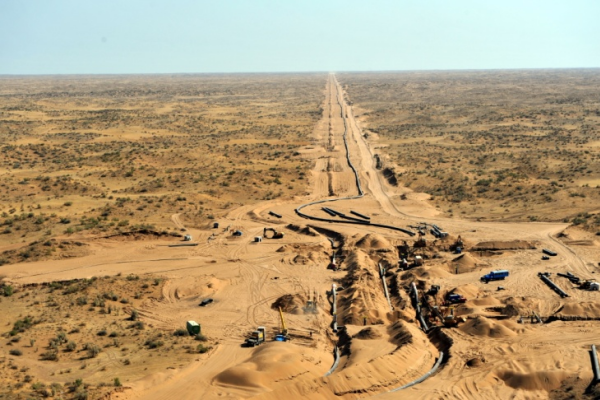In the vast deserts of Central Asia lies the China-Central Asia natural gas pipeline, the first China-built transnational onshore natural gas import pipeline.
Central Asia, historically a trade hub connecting the East and the West along the ancient Silk Road, boasts breathtaking natural landscapes and abundant reserves of oil and natural gas discovered in the 20th century.
Due to historical reasons, Central Asia's abundant natural gas was previously exported through a single pipeline, resulting in low prices and significantly reducing the income of the gas-producing countries.
Following the intentions reached between Chinese and Central Asian leaders regarding the natural gas pipeline construction project, natural gas from Central Asia would gain access to a much broader market.
The construction of the long-awaited pipeline has garnered attention from all walks of life in China and Central Asia from its inception. The China National Petroleum Corporation undertook the construction of the gas pipeline, and achieved an impressive 28-month completion time.
In December 2009, Line A of the China-Central Asia natural gas pipeline was put into operation, followed by Line B in October 2010 and Line C in May 2014. Since then, natural gas from Central Asia has been continuously flowing to regions along the pipeline route and into China.

The China-Central Asia natural gas pipeline runs through the wasteland in Kazakhstan. [Photo provided by China National Petroleum Corporation]
In February 2016, natural gas transported by the China-Central Asia natural gas pipeline reached Zharkent County, Kazakhstan, a small town just 29 kilometers from the Chinese border at Horgos.
Amir, who lives in Zharkent, has taken over the restaurant from his father for over a decade. Before the natural gas pipeline was built, he used to get up early every day to chop wood and carry bundles of firewood to his kitchen. It took up a significant part of his morning.
Amir recalls those days, saying, "Sometimes we couldn't find wood or charcoal, so we had to close."
With the arrival of natural gas via the pipeline, Amir can now simply turn the gas stove on, and flames ignite instantly. He no longer worries about shortages of firewood and the walls of his restaurant being blackened by smoke.
Amir said with gratitude, "We finally have natural gas. The gas pipeline has changed our lives. Thanks to this great project, it has brought us tangible changes."
The natural gas from Central Asia also flows into China through the China-Kazakhstan border at Horgos. It runs along thousands of kilometers of pipelines, supplying industrial and residential gas to over 500 million people in China's 25 provinces, autonomous regions, municipalities, and Hong Kong.
Before the availability of gas from Central Asia, residents of Wuhan City in Central China's Hubei province had to wait in queues for up to three hours to refill their natural gas supply during times of gas shortages. With the arrival of Central Asian gas in Hubei, queuing for gas in Wuhan has become a thing of the past.

Horgos measuring station of the China-Central Asia natural gas pipeline [Photo provided by China National Petroleum Corporation]
Currently, the gas transported through this pipeline accounts for 13 percent of China's annual domestic consumption. Any interruption in the natural gas supply could lead to the loss of stable gas access for tens of thousands of households and businesses.
During the Chinese New Year holiday, which marks a peak time for domestic gas consumption, the operational risks of the pipeline equipment increase significantly. Inspection teams stationed at various compressor stations along the pipeline conduct meticulous checks every day. Despite the biting cold, they examined the station's equipment, from the power generation room to the electrical equipment area and the compressor area.
One of the Chinese engineers from the inspection team said that it feels like doing daily medical rounds as a doctor. Every time we see these machines running smoothly, it brings immense joy.
As a vital energy artery built under the Belt and Road Initiative, the China-Central Asia natural gas pipeline represents win-win cooperation between Chinese and Central Asian people, and it will continue to benefit countries and people along the route.
(Executive editor: Wang Ruoting)